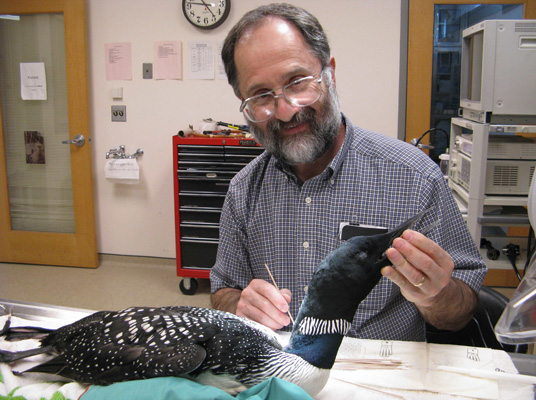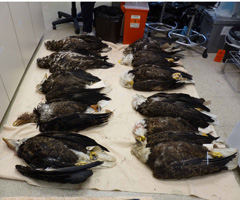Humans have used lead for thousands of years. Scientists can track the pernicious legacy of this heavy metal from ancient pottery shards to modern fishing tackle. Studies in people have shown even tiny amounts of this toxin can kill brain cells and trigger “invisible diseases” such as impaired learning and criminal behavior later in life. Large doses of lead cause seizures, comas, or even death.
In animals, the subtler signs of lead poisoning are often missed, says veterinarian Mark Pokras of the Cummings School of Veterinary Medicine at Tufts University in North Grafton, Massachusetts. Frequently, we discover toxic levels of lead in animals only after they’re dead. Lead-based ammunition still endangers California condors, and leaded fishing gear puts many waterfowl at risk.
Although legislation banned the use of lead in paint and automobile fuel, people still pollute our environment with other sources of the toxin. Worse, the heavy metal never degrades. Soil-based sources recirculate through fires and floods.
To discuss new solutions to this old threat, Pokras joined a panel of experts in the symposium “Lead: The Global Poison — Humans, Animals, and the Environment” at the February 2013 meeting of the American Association for the Advancement of Science in Boston. The resurgence of lead created a surge of media interest, and it took two interviews before SciCom’s Elizabeth Devitt got the full story.
When did you start working with wildlife?
After I got my biology degree from Cornell, I got a job monitoring osprey eagle nests to study the effect of DDT. I worked from Chesapeake Bay to the Maine border. Back then, they didn’t have as many nests in that whole territory as they now have in all of Massachusetts.
I’d study the osprey nests, band birds, and take eggs and dead chicks to labs. I was doing grunt fieldwork, but I was getting to know the gung-ho scientists who were looking at DDT metabolites and doing the work that eventually led to the ban. So I can say I had a tiny part in banning DDT: I drove the osprey eggs to the lab.
How did your career wind from osprey eggs to wildlife medicine?
I worked for an environmental consulting group next. I spent three years in the dark underbelly of the regulatory process. The consulting firm had been hired to do environmental planning for an offshore floating nuke plant, off Atlantic City. There was a lot of environmental impact work the public was not aware of. I tried working with the Atomic Energy Commission — this was before the Nuclear Regulatory Commission existed — but I was getting nowhere. So, I was a whistleblower. I sent an open letter to the press and, along with some other folks, held an environmental symposium. My actions weren’t the only thing that sunk the project. . . but I needed another job.
"We’re taking a known toxin and putting it into our environment at the rate of tens of thousands of tons per year. So it makes sense to ban it completely."
So, I started teaching at a small college in New Jersey. I co-taught environmental studies and marine biology with my wife. It was the early 70s and the tail end of the idealistic 60s; we all wanted to go out and change the world, save things and have a lot of impact. We had also started a wildlife rehab center. It was great. We could offer a wildlife rehab course, give a lecture, and then students would come over to clean cages and feed owls.
Then, I sat down for dinner and some good wine with a dear friend who asked me: Have you ever thought about veterinary medicine? It was like a door opening for me — a look into the weird, wonderful field of veterinary medicine. I got all excited. They were just admitting the second class to Tufts, so I applied.
You work with all kinds of wildlife, but you’ve focused on lead in loons for more than three decades. You discovered almost half the dwindling population of loons in New Hampshire were poisoned by lead fishing tackle. How did your work with the loons begin?
In the middle of my residency in the wildlife clinic [at Tufts], a biologist called from New Hampshire and said she had a dead loon. She asked if I could tell her why it died. Well, that was a challenge.
When I took an x-ray and saw fishing gear in it, I knew it was lead. At that time, there was a lot in the literature about lead poisoning in other animals, but not in the loon. I said to myself, “that was a weird case,” and then made one of the seminal mistakes of my career: I told her if she ever got another dead loon to give me a call. That was 2,000 loons ago, back in 1987. By 1989 we knew we had a phenomenon going on.
Does lead affect animals differently than people?
We’re spending 99.9 percent of our research dollars on lead in people, which is good for our species, but our ignorance is vast in animals.
We do know that lead is toxic in every vertebrate taxon studied. No species is immune. But in human medicine, we don’t see the extreme cases. In animal medicine we still see thousands of acute clinical cases of vomiting, diarrhea, paralysis and seizures.
We know almost nothing of sublethal effects, such as subtle behavior changes that will impact predation. People are great sentinels for veterinarians. We tend to detect problems at a lower level of occurrence [in humans], and that can help us with animals.
There’s also lead in aquatic systems. Where’s the uterus for fish and amphibians? It’s the pond, the river, the lake — and we’re not paying attention to the effects of lead there. We’re also not paying attention to invertebrates; we know very little about the effects on them, but what we do know causes us to be nervous.
I think I’m like many people and thought taking the lead out of gas and paint solved our problems.
There’s a lot of lead out there, and legislation is largely inadequate.
First of all, there’s huge industry pushback. If you pull up your car at a local station, you won’t put leaded gas in your car, but leaded gasoline is still legal in this country for off-road use. Aviation gas is still leaded.
One of the ways the industry wins the battle, or at least slows down the progress, is to lobby legislators and narrow the focus of the legislation. They say: Don’t take the lead out of all gas, just take the lead out of gas for such-and-such a purpose.
But not enough people consider the life cycle of lead. So often we focus on the product: lead in gas or in paint. Regulations are designed to deal with different things. The Consumer Safety Commission looks at lead in toys; Fish and Game deals with wildlife. In agency after agency, no one’s looking at lead in its totality.
Hunting, shooting, and fishing put tremendous amounts of lead in the environment. There are 25,000 to 30,000 tons [per year] that go into the environment. In soil, lead concentrates in earthworms. One earthworm can contain enough lead to kill the bird that eats it.
You’re working on New Hampshire Senate Bill 89, aimed at protecting the state’s loon population by prohibiting toxic lead fishing sinkers and jigs weighing one ounce or less.
Back in 1993, we tried to introduce federal legislation to get lead out of sporting goods. It got to the point of having a Senate hearing. But it was so controversial that the Senate committee tabled it and let it die.
When it became apparent that we couldn’t get anything done at the federal level, our next approach was to see if we could take some states where we have the most data, line up those states, and use a domino effect to get something done nationwide. Now, New Hampshire, Maine, New York, Vermont, and Massachusetts all have some kind of regulation to limit the use of lead in fishing tackle.
From a medical point of view, we’re taking a known toxin and putting it into our environment at the rate of tens of thousands of tons per year. So it makes sense to ban it completely. But legislators get a lot of pushback from sportsmen, anglers, and manufacturers who say: Show us the data. The problem is we don’t have a lot of data from that many species. We have data for loons, bald eagles, trumpeter swans, and mourning doves, but the data is splotchy.
So you can either try to be a purist and get all the lead out of everything, or pragmatic and do it in baby steps. That’s what we’ve done. But that’s resulted in regulations that are different in all five states. From the point of view of the angler and the companies that make lead products, that’s not helpful. Now, we’re trying to get protection for animals and uniformity for manufacturers.
In a perfect world, what would you like to see done about lead?
If we could ever go back to square one, we’d ask: What are all the things in the world that we use lead for? And then we could rank [these things] by relative importance of need — is it essential or not? X-ray shielding may be one of the top things we need to keep, for example. Then we’d figure out which ones are easy to replace because it would be cost-effective, such as fishing sinkers.
From a medical perspective, I’d like to say: Get all the lead out, we don’t need it. From a realistic perspective, we probably can’t do that. But I think we can do that in a graded fashion. Then we need to look at technological alternatives, find something better for whatever we replace — and give ourselves a good ten-year time window.
What are the next steps to get there?
Awareness, education, and policy.
That said, we can educate people all we want, but somewhere you need something to push people to do the right thing. If a lead sinker is still 50 cents cheaper, they’re going to go with what’s cheaper.
So, I think a sin tax is the way to go. Have a tax on toxic stuff, use the tax for environmental research or do tax incentives. Let’s push small industry, let them be innovative and find new stuff that will do the same as lead without the toxicity. It doesn’t need to be rocket science.
It shouldn’t be hard to fix. We have known about this for so damn long.
____________________
Elizabeth Devitt, a graduate student in the Science Communication Program at UC Santa Cruz, earned her bachelor's degree in zoology from the University of Vermont and her doctorate in veterinary medicine from Tufts University. This year, she has worked as a reporting intern at the Monterey County Herald, the Stanford University School of Medicine, and the San Jose Mercury News. She will report this summer for Nature Medicine in New York as a science writing intern.
© 2013 Elizabeth Devitt


